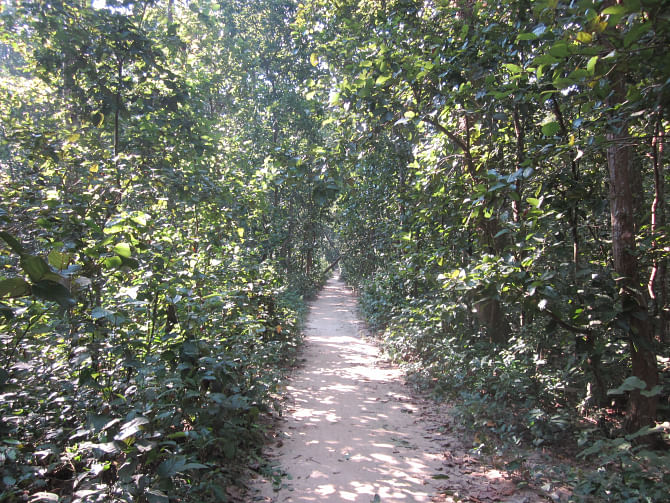Emptied, silence grips the sal forest

Nature has taken 'a vow of silence' in Singra Forest. The trees are beautiful, no doubt. The shade's cool is noticeable. The sunlight filtered by sal leaves makes its expected display of light and shadow and soothes the soul. It's a place for the laughter of winter picnics.
From the forest beat office there's a stream to wade through to get into the heart of Singra. But it's a forest that's lost its heart. Like a theatre stage arranged with sets, microphones and lights, but where actors will never come, in Singra there's barely the sound of a bird. Nature is keeping mum.
Those termites that live, unseen, in their earthen mounds must be the most telling: forest decay.
It wasn't always this way.
Large tracts of Dinajpur district were once covered in sal forest, an extension of the Duars forests of the Himalayan foothills in Paschimbanga where you can still find the rhinoceros.
Until the end of the nineteenth century, Dinajpur was animal rich. Tigers and leopards were widely distributed; otters, jungle, fishing and leopard cats common.
Birganj was “so notorious for tigers,” reads the District Gazetteer, “that no traveller would pass through it at night, or even in the daytime if alone.”
But by 1911 tiger, buffalo and swamp deer were “only a memory.” Smaller cats remained some decades more, with leopards making their last stand in any numbers in ruined temples and mosques, in old graveyards and abandoned homes.
Felling of forest trees peaked in anticipation of the enactment of the Bengal Private Forest Act of 1945, with landlords seeking quick profit. Partition encouraged more tree felling before people left for the other side.
And since? According to the beat officer, Singra barely has a tree predating 1971.
People are busy: Bangalee and Santal, guiding their cattle through the undergrowth to grazing spots. It's noisy. Can you hear their voices? Villagers are collecting sticks for firewood moving about like wild fowl once did. There's a large square clearing of unclear origin and bicycles and Hondas (motorbikes) coming through. There's the sound of an axe and lorry tracks.
Snakes still occasionally visit the beat office. The bushes rustle as a monitor lizard passes – and that means there must be rats and probably those shrews that are common in Dinajpur town.
But the monkey, porcupine, wild boar, wild cock, fishing cat, deer, bongaru and nilgai have their memorial made in the list of lost species on the Singra National Park signboard. The small 305.69 hectare park was established in 2010 – better late than never?
The signboard says the rabbit, fox, snake and mongoose remain. That's the wildlife of many a village too. A forest should do better.
There's talk of building a bridge over the stream to let the tourists in. But while ever the busy forest is so empty, why not let us wade?

 For all latest news, follow The Daily Star's Google News channel.
For all latest news, follow The Daily Star's Google News channel. 



Comments